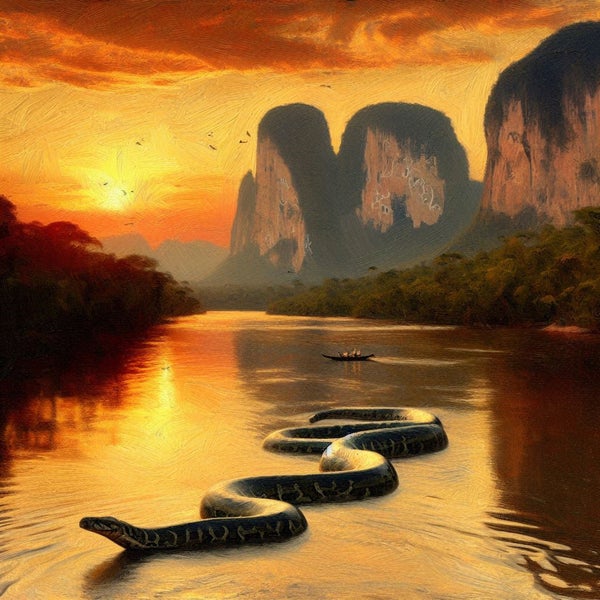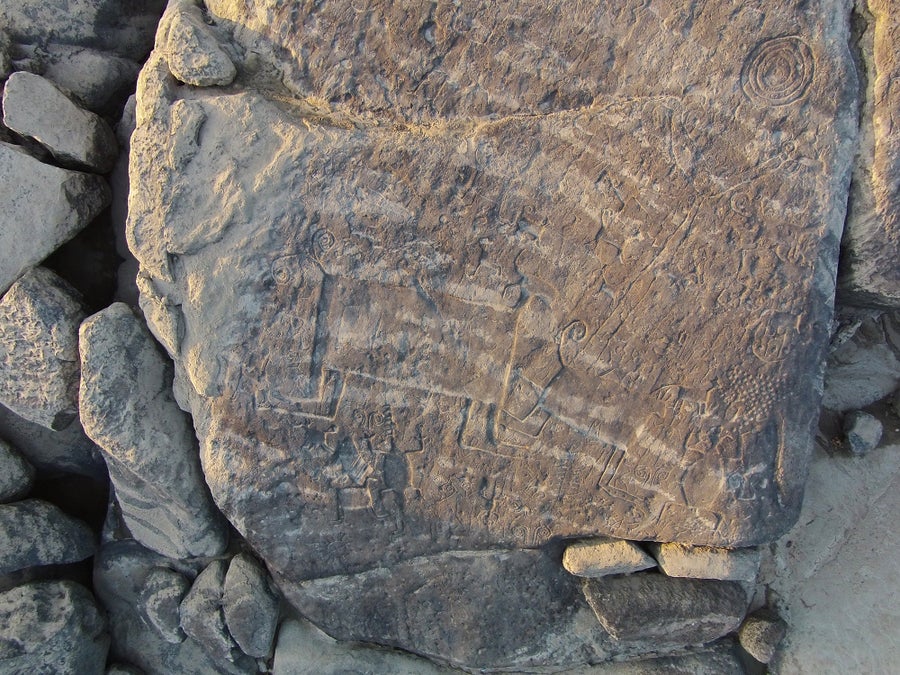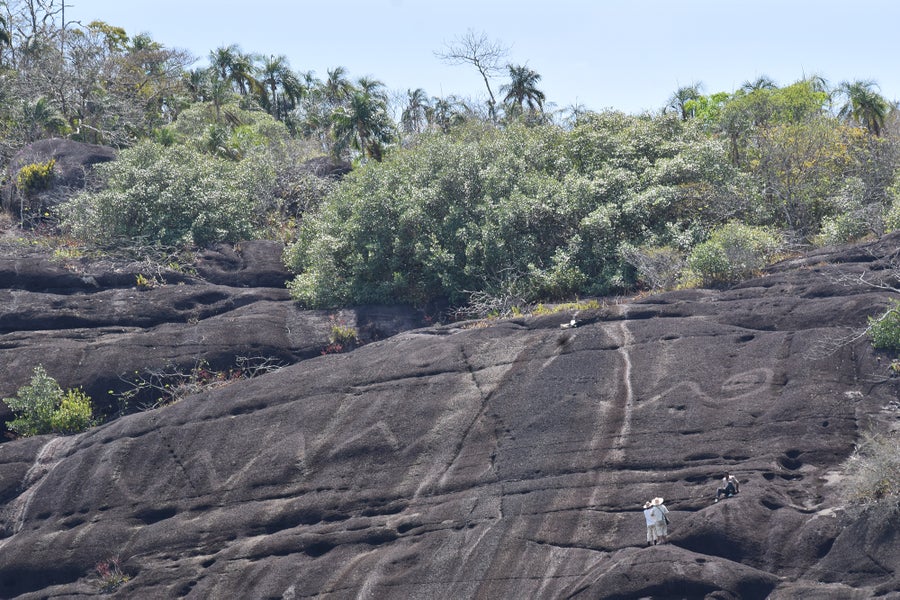Enormous engraved rock art of anacondas, rodents and other animals along the Orinoco River in Colombia and Venezuela may have been used to mark territory 2,000 years ago

Artistic impressions of a mythical snake traversing the Orinoco River.
Dr Philip Riris
Skim along the Orinoco River on the border between Venezuela and Colombia, and you might catch glimpses of a mythological spirit world engraved into rocks lining the riverbanks.
Depictions of anacondas, centipedes, human figures and giant rodents are among the engravings, which may hark back to myths told for more than 2,000 years. Now the first scientific documentation of this art finds that some of these engravings are among the largest in the world. Their size makes them visible from a distance, suggesting they were used as ancient signposts that told travelers along the prehistoric trade route whose territory they were entering and leaving. The new findings were published on Monday in Antiquity.
The engravings may represent mythological traditions that continue today, says archaeologist and anthropologist Carlos Castaño-Uribe, scientific director of the Caribbean Environmental Heritage Foundation in Colombia. Castaño-Uribe was not involved in the new study, but for more than a decade he has worked to conserve the natural and cultural heritage of Indigenous people in the region whose beliefs still center the myth of a supernatural anaconda ancestor. “They continue to consider it one of the most transcendent [archetypes] of their mythical world,” Castaño-Uribe says, “and of their spiritual symbolism, where it is associated with fertility, water, abundance and … the advent of the different tribes, clans and families of the main river arteries of this vast region.”
On supporting science journalism
If you’re enjoying this article, consider supporting our award-winning journalism by subscribing. By purchasing a subscription you are helping to ensure the future of impactful stories about the discoveries and ideas shaping our world today.
Though area residents have long been aware of the rock art, the archaeology of the Middle to Upper Orinoco had been little studied by outsiders, says paper co-author José R. Oliver, a reader in Latin American archaeology at University College London. He and his co-authors, Philip Riris of Bournemouth University in England and Natalia Lozada Mendieta of the University of the Andes in Colombia, wanted to document these sites both for scientific and conservation reasons. They surveyed a region centered around the Atures Rapids in the Middle Orinoco, a place where the river becomes impassable by canoe and travelers have to portage over land. “Everything we knew about the archaeology of the region suggested that it was this meeting point where different cultures came together and actively traded and, in some cases, probably intermarried,” Riris says.

Orthophoto detail of monumental rock art on Picure Island, Venezuela.
Dr Philip Riris
Between the Colombian city of Puerto Carreño downriver and the Maipures Rapids upriver, the researchers found 157 rock art locations, including more than a dozen with engravings that are more than four meters (about 13 feet) long. The largest, an anaconda, measures more than 40 meters (about 130 feet). Riris says it is likely the largest known prehistoric rock engraving in the world.
The images were produced by chipping away the granite surface—which in this region is stained dark by untold years of bacterial growth—to reveal the lighter rock beneath. Some of the engravings are usually below the waterline and only visible in seasons when the river is low, Oliver says. Others are a short distance away from the banks, on large granite outcrops that stand over the savanna landscape of the river basin. There are also engravings, and occasionally paintings, in natural rock shelters near the river.
Some of the largest engravings depict anacondas, which are always positioned to be visible from the river. The anaconda is a sacred spiritual figure in the region’s mythology, Riris says. The snakes are swimmers and are associated with exploration. “They are the ancestral being that can transport you as you travel,” Riris says. “They’re metaphorically a type of canoe.”
Local Indigenous peoples still incorporate the rock art in their beliefs. For some groups, viewing the art is considered taboo for women. Oliver says members of one ethnic group, the Piaroa, tell a tale of a mythological figure called Kuahuayamo Ato, or “Serpent-Maize,” the owner of all vegetables. She is said to have traveled the river, singing and shedding tears, which created the rock art.

Telephoto shot of monumental rock art of snake body in Colombia, humans for scale.
Dr José Oliver
The new study “makes visible and documents the importance of this serpentine iconography of great cultural value in much of pre-Hispanic South America,” Castaño-Uribe says.
Riris says the engravings’ motifs match those used on pottery from about 2,000 years ago. Rock art in the region’s rock shelters was already known to date back at least 3,000 years, the researchers wrote. It’s unclear when local peoples stopped making new rock art, Oliver says, as writings by the Spanish people who arrived in Colombia in 1499 don’t mention any new activity.
There is no way to know for sure the people who made the rock art had the same stories about it as the Indigenous people in the area today, says Edithe da Silva Pereira, an archaeologist at the Emílio Goeldi Museum of Pará (MPEG) in Brazil, who was not involved in the new paper. “Specific work is needed with these peoples to understand the link they have with these sites,” she says. There is a similar site in Brazil called Pedra Preta de Paranaíta (“Black Stone in Paranaíta”), Pereira notes, where the snake motif is also present.
Further fieldwork could help pinpoint when the rock art was made, says Trond Lødøen, an archaeologist and rock art expert at the University Museum of Bergen in Norway who was not involved in the study. Though the rock engravings themselves are inorganic and thus can’t be radiocarbon dated, Lødøen says that beneath the rock faces, there may be tool fragments, charcoal layers from ancient fires or bits of pottery that could be dated. “This whole paper is like a teaser,” he says. “There’s more to come.”
Note: This article have been indexed to our site. We do not claim legitimacy, ownership or copyright of any of the content above. To see the article at original source Click Here












